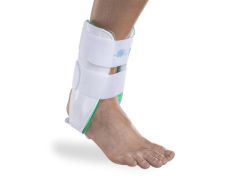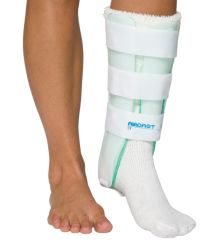Stress Fractures
What Causes Stress Fractures
The major cause of stress fractures is overuse. They are especially common in athletes that participate in high-impact activities, such as basketball, gymnastics, tennis, and long-distance running. They can also happen if you are leading a relatively sedentary lifestyle and suddenly pick up physical activity, for example, suddenly spending a lot of time walking around in the city when you don't normally or starting to run. This occurs because your muscles are not yet trained to absorb repeated shock. Basically, doing "too much too soon" can lead to stress fractures. Teenagers who are still growing are at risk because their bones may not yet have fully hardened. Individuals with weakened bones from conditions such as osteoporosis are also at risk.
Outside factors may also contribute to stress fractures. This includes poor training or technique when performing exercises. Poor exercise equipment like footwear can also lead to stress fractures, such as shoes that have worn cushioning or not enough foot or arch support.
What are the symptoms? What does a Stress Fracture Feel like?
Stress fractures are associated with gradual pain that increases during weight-bearing activity. The pain may decrease with rest or even go away entirely when you aren't doing the activities that cause pain like running, walking or jumping. There may also be swelling on the top of the foot, around the ankle or the shin. The area of the stress fracture may feel tender to the touch, and in some cases bruising may be present. You might feel a generally dull pain with sharpness with each step.
What is the Treatment?
Your physician will often recommend that you stop the activity that is causing you pain, recommend you use cold therapy, and wear a walking boot depending on the severity of stress fracture.
Rest
Regardless of whether you have a metatarsal stress fracture, ankle, or shin stress fracture, start with rest - lots of it! Continuing activity may cause the bone to become further stressed and can result in a complete fracture or break.
Cold Therapy
Ice, ice and ice some more with ice packs or cold compresses. Apply ice to the injured area to help reduce pain and swelling.
Anti-inflammatory with caution
Anti-inflammatory medications such as ibuprofen and aspirin may be used to alleviate pain, however, they can also inhibit bone healing. Consult your physician.
Recovery Time
Stress fractures typically take 6 to 8 weeks to heal, and it is normally recommended to switch to non-weight bearing activities such as swimming and biking. Make sure you consult your doctor for which activities are appropriate for your recovery.
Wearing an ankle brace such as the Aircast Air-Stirrup may also help you heal more quickly from a stress fracture and prevent re-injury. For lower leg stress fractures products such as the Aircast Leg Brace have been recommended by physicians and medical professionals. Some types of stress fractures may need a cast or a medical walking boot like the Aircast Airselect Short, because those bones take longer to heal.
For more serious stress fractures, surgery may be required. A fastener will be placed in the bones to hold them together during the healing process. However, most fractures will heal on their own with rest and time, and surgery is not usually required.
How to Prevent a Stress Fracture?
Stress fractures may be prevented by proper training and technique. This helps prevent muscle fatigue and bone loss. Eating foods rich in calcium and vitamin D can also help build up your bone strength. When starting new activities, make sure to do it gradually, then slowly increase time and distance. Also make sure to wear proper shoes and equipment.





 Stress fractures are tiny cracks in your bones that occur when overly tired muscles can no longer absorb the shock of repeated impact. When this happens, the forces are transferred to your bones, causing stress fractures. Stress fractures are most common in weight-bearing bones in the foot, shin and ankle.
Stress fractures are tiny cracks in your bones that occur when overly tired muscles can no longer absorb the shock of repeated impact. When this happens, the forces are transferred to your bones, causing stress fractures. Stress fractures are most common in weight-bearing bones in the foot, shin and ankle.

